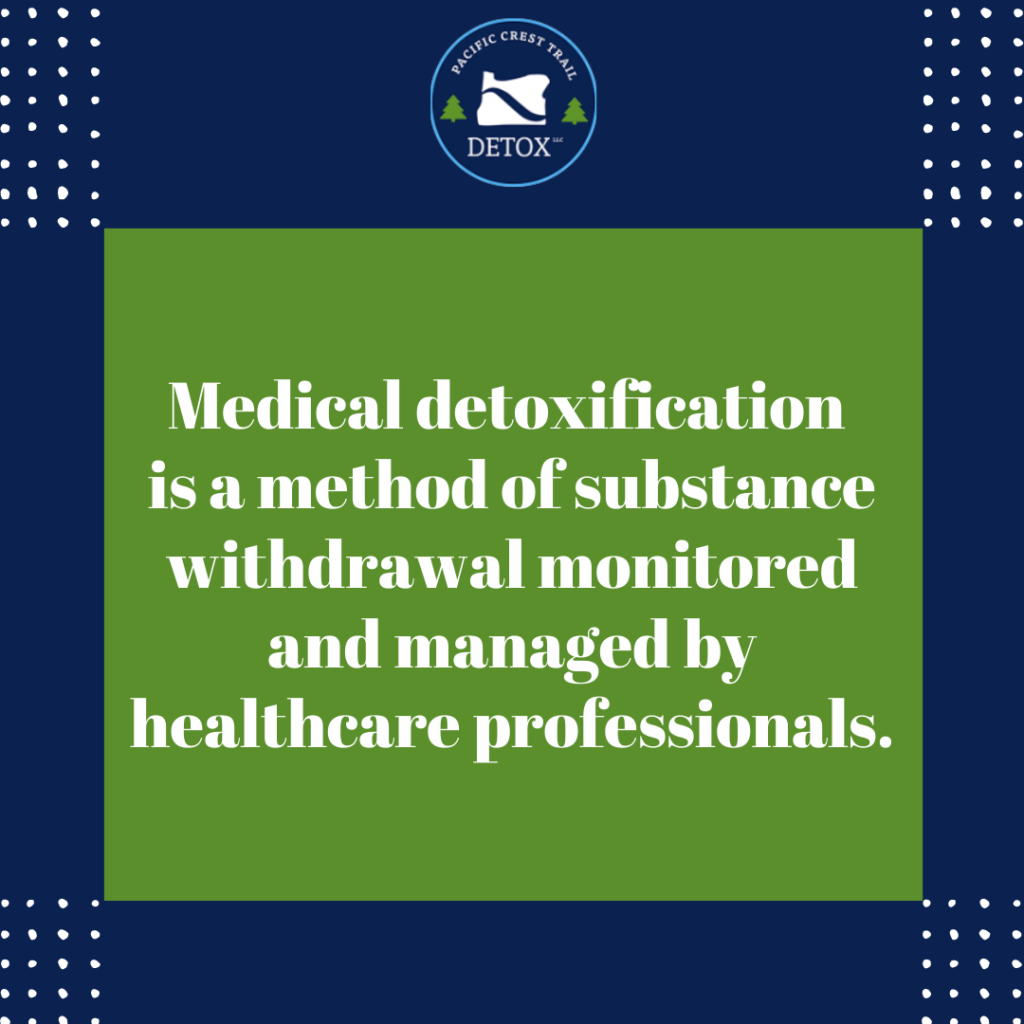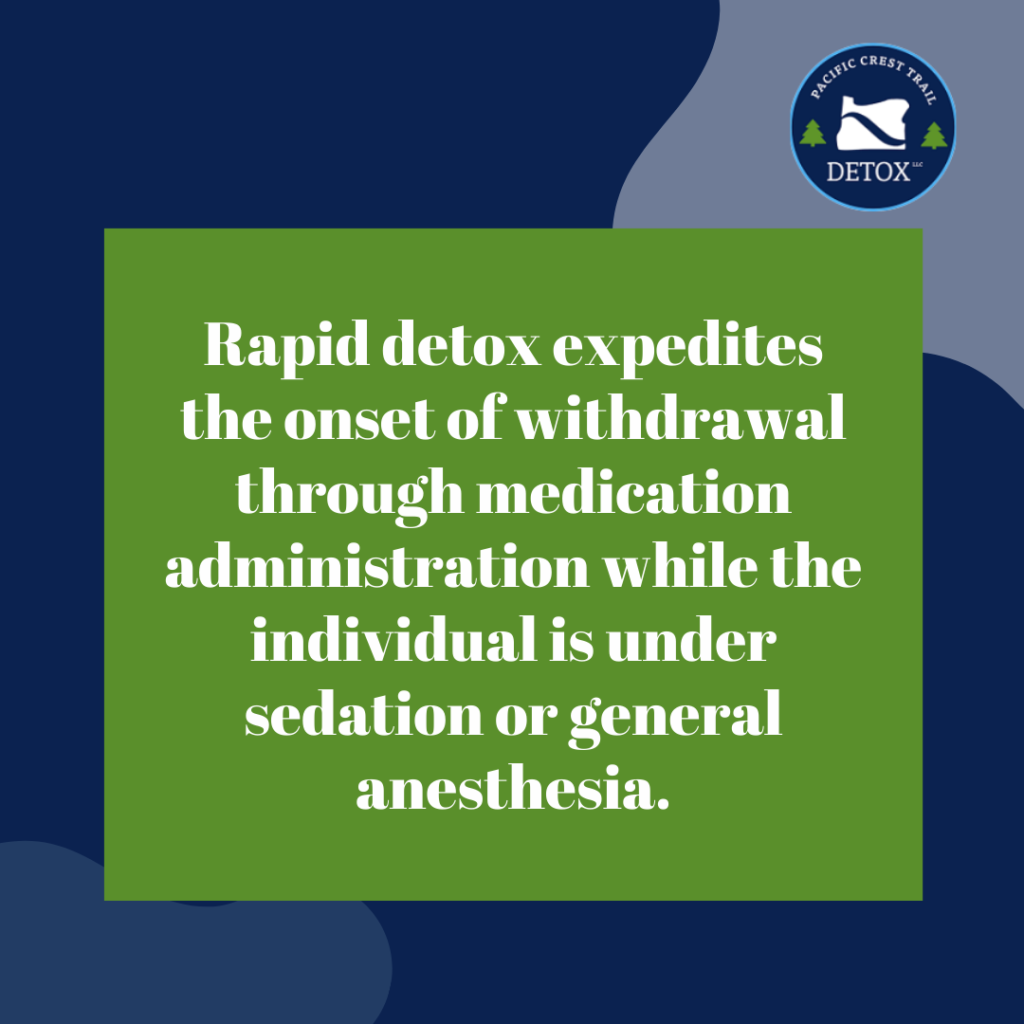Rapid drug detox is a buzzword that has been going around the world of addiction treatment for a while now. It promises a swift and seemingly easier way to cleanse the body of harmful substances.
But does rapid drug detox work? Is it effective and safe? These are questions that any individual or family facing the harsh reality of substance abuse must ask.
In this blog post, we’ll look into detoxification, compare various detox methods, and discuss the vital role of medical detox. Moreover, we introduce you to the unique approach of Pacific Crest Trail Detox, which holds a compassionate yet effective approach to addiction recovery at its core.

What is Medical Detox?
Medical detoxification is a method of substance withdrawal monitored and managed by healthcare professionals. It is often the first step in a comprehensive addiction treatment program, laying the foundation for the subsequent stages of recovery.
This step is critical as it helps the individual break free from the physical dependence on the substance, preparing them for the following therapeutic interventions.
The Role of Medical Detox
The primary role of medical detox in a treatment program is to mitigate the risks associated with withdrawal symptoms. These symptoms could be life-threatening, depending on the substance and the severity of the addiction.
This is where the expertise of the medical team comes into play. They monitor vital signs, manage withdrawal symptoms, and ensure the patient’s comfort throughout this challenging period. The goal is to minimize physical discomfort and psychological distress, ensuring a safe and smooth transition to sobriety.
Stages and Timeline Involved in the Drug Detox Program
The medical detox process can be divided into three stages: evaluation, stabilization, and transition to further treatment.
- Evaluation: This stage involves a comprehensive assessment of the individual’s physical and mental health, substance use history, and any underlying medical conditions.
- Stabilization: This is the active phase of detox, focusing on managing withdrawal symptoms and ensuring the individual’s safety. This stage can take anywhere from a few days to a couple of weeks, depending on the substance and the severity of the dependence.
- Transition to further treatment: Once the individual is stabilized and the acute withdrawal symptoms are managed, the focus shifts to the next recovery phase.
Remember, detoxification is not a cure for addiction. It’s an essential first step in the recovery journey, setting the stage for the following healing work. It is part of a broader, more comprehensive treatment approach that includes therapy, counseling, and ongoing support.

Understanding Rapid Detox Centers
Rapid detox centers are a relatively new development in addiction treatment. They offer what is often marketed as a “quick fix” to addiction, claiming to expedite the detoxification process significantly. This method is particularly prevalent in the management of opioid withdrawal.
What are Rapid Drug Detox Centers?
Rapid detox centers offer a procedure known as “rapid opioid detoxification” (ROD) or simply “rapid detox.” The process typically involves the administration of medications that accelerate the onset of withdrawal while the individual is under sedation or even general anesthesia.
The theory is that the patient can sleep through the worst withdrawal symptoms, waking up free from physical dependence on opioids.
How Rapid Drug Detox Centers Differ from Traditional Detox Centers
Its main difference with the traditional method is the approach and timeline. Rapid detox centers promise a quick and relatively painless withdrawal process, with detoxification completed within hours to days.
In contrast, traditional detox centers focus on a gradual, medically monitored withdrawal process, typically spanning several days to a few weeks.
Traditional detox centers also place a significant emphasis on the psychological aspects of addiction, providing counseling and therapeutic interventions alongside medical management. This holistic approach acknowledges that addiction is not just a physical disease but also a mental and emotional one.
The Process Involved in Rapid Drug Detox Programs
In a typical rapid detox program, the individual is first sedated or put under general anesthesia. Next, they are administered medications like naltrexone, which precipitate withdrawal by blocking opioid receptors in the brain. Because the patient is unconscious, they are not aware of the intense withdrawal symptoms that ensue.
After the procedure, the patient wakes up and is often given additional medications to manage lingering symptoms.
While rapid detox may sound appealing due to its quick turnaround, it’s essential to understand that this method has raised significant concerns in the medical community. There are questions about its safety, effectiveness, and long-term outcomes.

The Concept of Traditional Detox Centers
Traditional outpatient detox centers offer a more comprehensive and nuanced approach to addiction treatment than rapid detox. These centers understand that addiction is a complex issue involving physical dependence and psychological, social, and emotional factors.
How Traditional Detox Centers Operate
Detox centers like Pacific Crest Trail Detox begin with a thorough pre-admission screening. This process involves a comprehensive evaluation of the individual’s physical and mental health, substance use history, and any underlying conditions. This information is crucial in creating a personalized detox plan tailored to the individual’s needs.
Once admitted, the individual starts the detoxification process under medical supervision. Healthcare professionals monitor vital signs, manage withdrawal symptoms, and ensure the patient’s safety and comfort. This gradual withdrawal typically spans several days, depending on the substance and the severity of the dependence.
In addition to medical management, traditional detox centers also provide psychological support. This could include individual therapy, group counseling, and other therapeutic interventions to address the underlying issues contributing to substance abuse.
Rapid Detox Centers vs. Traditional Detox Centers: A Comparison
Rapid and traditional detox centers differ significantly in their approach to addiction treatment.
- Approach: Rapid detox centers focus primarily on accelerating the physical withdrawal process. In contrast, traditional detox centers gradually address addiction’s physical and psychological effects.
- Safety: Rapid detox, particularly when it involves general anesthesia, comes with risks, including potential complications from the anesthesia itself. Traditional detox, under the supervision of healthcare professionals, minimizes these risks by closely monitoring the individual’s health throughout the process.
- Long-term outcomes: Rapid detox does not address the psychological aspects of addiction, which can leave individuals ill-equipped to manage cravings and triggers in the long term. Meanwhile, traditional detox centers provide a more comprehensive treatment plan, including therapy and counseling, to equip individuals with the tools they need for long-term sobriety.

While the promise of a quick fix may be enticing, you need to be aware of what it entails when going for a treatment. The goal of addiction treatment is not just to stop substance use but to provide individuals with the skills and support they need to maintain sobriety in the long run.
And that’s precisely what a traditional opioid detox center like Pacific Crest Trail Detox does. Our dedicated professionals are ready to guide you or your loved one every step of the way, from the initial detox phase to the transition into residential treatment and beyond.
Call us at Pacific Crest Trail Detox today, and let us walk this path to recovery with you. Your journey to a healthier, substance-free life starts here.
